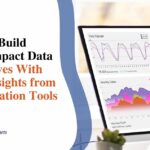3 Essential Data Types for Waterfall Charts: Elevate Your Data Story!
A waterfall chart is a popular data visualization tool used to understand how an initial value changes over time due to intermediate positive or negative contributions. By representing sequential data changes in a visually appealing way, waterfall charts simplify complex information to highlight key trends, variances, and overall net impact.
Understanding common data types used in waterfall charts empowers analysts to build more informative charts that elevate the data story. This guide covers three essential waterfall chart data types and practical tips for effective data visualizations.
What is a Waterfall Chart?
A waterfall chart displays columns of values, with intermediate values flowing left or right depending on whether they increase or decrease the running total. After all previous additions and subtractions, the final column shows the end net value.
Waterfall charts effectively visualize financial statements like profit and loss accounts, displaying starting and ending account balances while mapping positive and negative contributions in between. Beyond finance, waterfall charts also provide insight into customer acquisition/loss trends, production forecast variances, project milestone progress, and more.
Benefits of Using Waterfall Charts

Here are some key reasons waterfall charts make data easier to understand:
- Clear visualization of sequential data changes: The flowing waterfall format connects each data point to show the cumulative impact of multiple variables over time or across categories.
- Highlights individual contributions to the total: The segmented columns distinctly separate and label each intermediate value so you can pinpoint its effect.
- Simplifies complex data into an easy-to-understand format: Condensing detailed data points into a clean waterfall diagram simplifies complex information for quicker analysis.
- It helps identify key drivers of change: Visual separations between columns clearly show the biggest positive and negative impacts over a period.
- Effective for financial analysis, including profit and loss statements: The format lends itself well to depicting account balances, allowing analysts to map contributions to net profit or net loss.
- It shows the cumulative impact of multiple data points: The final column presents the net cumulative change from all previous columns, showing the total impact of all variables together.
Data Types for Waterfall Charts
To build informative waterfall charts that analyze data effectively, analysts need to understand the relevance of these three essential data types:
Essential Data Type 1 – Categorical Data
Categorical data labels and organizes data points into qualitative groups or categories. Using descriptive categories on waterfall chart columns provides context for each data point.
For example, a profit/loss waterfall chart may have categories like Sales Revenue, Cost of Goods Sold, and Marketing Expenses. Categorical data enables viewers to grasp the real-world components of each data measure.
Effective use of categorical data also involves limiting the number of categories to avoid an overly complex chart. Analysts should consolidate or remove categories unlikely to provide actionable insights.
Essential Data Type 2 – Time-Series Data
Time-series data measures variables over uniform time intervals. Using a time element enables waterfall charts to display changes in accounts and values across specified periods.
For example, a monthly profit/loss waterfall chart assigns each column to a distinct month, connecting how income statement components evolve monthly. This chart tracks meaningful trends in account progress over time.
Time-series data can fuel comparison across periods to identify anomalies in the data or understand variability and rates of change. Analysts can use this insight to predict future time horizon behavior better.
Essential Data Type 3 – Quantitative Data
Quantitative data represents measurable numeric information. The quantitative money values represented in each waterfall column constitute the core foundation of an informative chart.
Accurately measured quantitative data ensures analysts can take reliable data-driven actions. It also enables precise illustrations of net impacts and individual contributions of each component to overall variances.
Analysts should always validate the accuracy of financial or operational data inputs into waterfall charts for quantified data integrity.
Practical Tips for Effective Waterfall Charts
When incorporating essential data into waterfall charts, here are some best practices:
1. Start with a clear baseline
The first column in a waterfall chart represents the starting or baseline value. This baseline provides a reference point to compare against for assessing the impact of subsequent changes. Clearly highlight this starting quantitative data value so readers understand the initial state before additional variables affect it.
2. Ensure logical data sequencing
Organize the waterfall chart columns in a logical sequence that maps the real-world process flow. This helps readers intuitively comprehend the chain of events. For example, a sales waterfall may show monthly customer acquisitions, followed by customer losses, before showing the final net gains/losses.
3. Use consistent colors for positive and negative values
Apply color coding consistently, using green for gains/profits and red for declines/losses. This color convention allows easier visual analysis of favorable vs unfavorable trends. Keep the color coding consistent across multiple charts for better comparability.
4. Label key data points clearly
Properly name each waterfall column to prevent ambiguity on what the data block represents. Descriptive categorical labels enable accurate interpretations. For highlighted blocks, include annotated notes explaining key drivers behind unusually high or low values.
5. Avoid overcrowding with too many categories
Limit waterfall categories to the most insightful ones and consolidate adjacent categories unlikely to offer meaningful analysis. Too many columns clutter the chart, overwhelming readers rather than clarifying the core story.
6. Highlight significant changes or key contributors
Emphasize chart columns depicting disproportionate contributions with contrasting colors, bold outlines or font callouts. This draws attention to the segments warranting drill-down analysis to uncover root causes.
7. Keep the chart simple and uncluttered
While trying to demonstrate analytical rigor by incorporating all data complexities, simplicity and clarity should take priority in waterfall depictions. Declutter backgrounds, minimize dense text blocks and focus on cleanly separating key data columns.
8. Use a consistent scale across the chart
Set standardized scales for the vertical y-axis across multiple charts covering different periods. Constraint consistency aids accurate trend analysis and proportionality assessments when comparing periods.
9. Consider the audience and adjust complexity accordingly
Evaluate chart consumers and customize simplicity levels based on their data literacy. Simplify charts for audiences needing just high-level overviews rather than every granular detail. Conversely, add layers of detail for specialist data analysts needing deeper inspections.
10. Test different layouts to find the most effective presentation
Experiment with horizontal and vertical waterfall orientations using the same data to determine the best directional flow and reader alignment. Testing both styles can clarify optimal layouts to emphasize key data stories.
Conclusion
Analysts can build clearer data visualization stories by leveraging essential waterfall chart data types like categorical, time-series, and quantitative data. Following key design best practices also ensures waterfall charts present complex information in easily consumable ways.
As data-driven business practices evolve, insightful waterfall charts will empower stakeholders at all levels to make informed strategic decisions. Organizations should invest in upskilling their teams to create meaningful waterfall data stories that reveal actionable trends.







